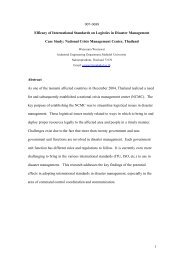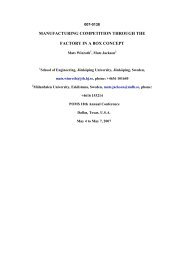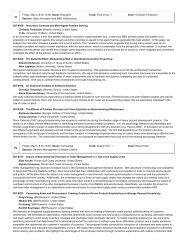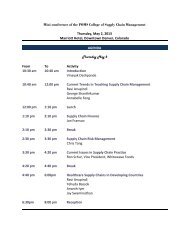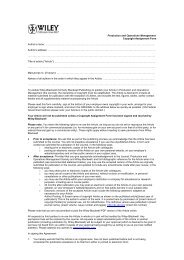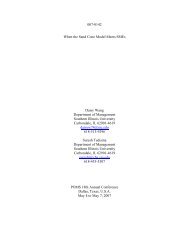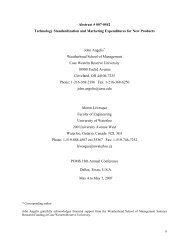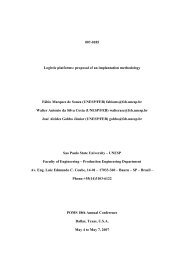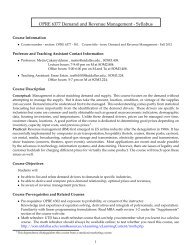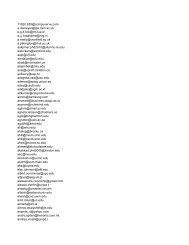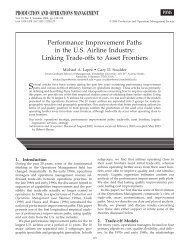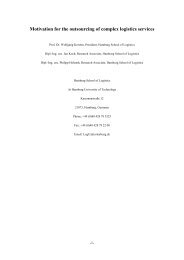Improvement of Lean methodology with FMEA - POMS
Improvement of Lean methodology with FMEA - POMS
Improvement of Lean methodology with FMEA - POMS
You also want an ePaper? Increase the reach of your titles
YUMPU automatically turns print PDFs into web optimized ePapers that Google loves.
007-0520<br />
<strong>Improvement</strong> <strong>of</strong> <strong>Lean</strong> <strong>methodology</strong><br />
<strong>with</strong> <strong>FMEA</strong><br />
Amir Shekari<br />
Iran University <strong>of</strong> science & technology (Behshahr Branch) & RWTUV Iran<br />
Tehran, Shahid Beheshti Ave., 156 block, 4 Floor, phone: 02188502787<br />
Shekari@engmail.ut.ac.ir<br />
Soheil fallahian<br />
Iran University <strong>of</strong> science & technology (Behshahr Branch)<br />
Soheil_f20022002@yahoo.com<br />
<strong>POMS</strong> 18 th Annual conference<br />
Dallas. Texas, U.S.A.<br />
May 4 to May 7, 2007
ABSTRACT<br />
Considering the degree <strong>of</strong> competition between companies in the world, advantages in<br />
competition will be won by those companies who focus on performance improvement, customer<br />
satisfaction, reducing the costs. In this way, lean production strategies can help us to identify and<br />
eliminate non value added resources. <strong>FMEA</strong> technique is applied to analyze the possible failures, in<br />
order to raise the safety factor and consequently costumer satisfaction.<br />
Considering the weak and strong points <strong>of</strong> each <strong>of</strong> these methods, and the synergy between them,<br />
simultaneous implementation <strong>of</strong> these two, leads to much better results comparing to their separate<br />
implementation. In this paper, we focus on implementing them together too; in a way that not also their<br />
specific abilities will not be lost, but also raise the overall performance <strong>of</strong> the organization. In the<br />
following, these two methods are compared from different aspects. Later, we combine their operational<br />
phases and represent flowchart.<br />
KEYWORDS<br />
<strong>Lean</strong>, <strong>FMEA</strong>, Value, Muda, Failure prevention, Reliability, Risk<br />
1. Introduction<br />
Considering the degree <strong>of</strong> competition between companies in the world, advantages in competition<br />
will be won by those companies who focus on performance improvement, customer satisfaction,<br />
reducing the costs and increasing the efficiency, and overlay try to purify their organizations and<br />
processes. In this way, production strategies and lean thinking can help us to identify and eliminate non<br />
value added resources. Besides, issues like competition, increase in expectations, changes in<br />
requirements, and alterations in technology, leads to more responsibility for producers on removing<br />
products deficiencies and deviation in processes. Otherwise, companies will lose their market share,
due to costumer dissatisfaction. In order to do so, today companies use tools called <strong>FMEA</strong> 1 . <strong>Lean</strong><br />
thinking is not an analytical method, yet implementing its operational principles and applications, can<br />
lead to changes in organizational culture, increase in efficiency and pr<strong>of</strong>iciency and better customer<br />
relationship. In order to avoid any kind <strong>of</strong> failures in production and development processes, and also<br />
estimating the problems and finding the most economic way to stop them, we use <strong>FMEA</strong> or prevention<br />
strategies. Today, companies need powerful methods for their business, in order to survive and promote<br />
their place in international competitions. In this article, we try to integrate two famous methods and<br />
represent a new <strong>methodology</strong> based on this integration. We hope this works, lead to satisfying the<br />
needs <strong>of</strong> today's companies [1, 2, 3].<br />
2. Failure modes and effects analysis<br />
In production and service businesses, issues like increase in customer expectations, growth in<br />
technology, and participation in international markets, leads to more competition between producers.<br />
So, producers are going after growing the quality <strong>of</strong> their products/ services and reducing any kind <strong>of</strong><br />
deficiency in them. Today, companies use <strong>FMEA</strong>. Using these tools, we can identify potential failure<br />
modes in system, processes, products and services, and then prioritize all potential them and then<br />
define and deicide some actions in order to prevent or decrease the possibility <strong>of</strong> these failures and<br />
finally we document this process (which eventually supply us <strong>with</strong> a good source for future problems).<br />
[1]<br />
<strong>FMEA</strong> technique is applied to analyze the possible failures, in order to raise the safety factor and<br />
consequently costumer satisfaction. One <strong>of</strong> the main differences between <strong>FMEA</strong> and other quality<br />
methods is that <strong>FMEA</strong> is an active method, while other methods are passive (are based on reaction):<br />
when failures occur, other methods define some reactions; but reactions have lots <strong>of</strong> costs and<br />
1 Failure mode and effects analysis
esources. <strong>FMEA</strong> tries to estimate the potential problems and their risks and then decide upon actions<br />
leading to reduce or eliminate this risk. This kind <strong>of</strong> preventive act is an action against what could<br />
happen in the future. it is obvious that determining about preventive actions, which happens in early<br />
phases <strong>of</strong> development, needs lower cost and time comparing to reactions[1,4].<br />
Figure 1 and table 2, shows the <strong>FMEA</strong> implementation process. As you can see, after initial<br />
planning, a new design is represented. Then it must be decided whether it has enough reliability or not?<br />
In order to answer this question, all potential failure modes in our design are identified and their<br />
importance will be estimated. if their effects is more than an acceptable limit, some actions will be<br />
proposed to reduce the risk; this way we can be sue that our products and process have proper<br />
reliability. it is important to mention that <strong>FMEA</strong> can not act alone, but they must be used along <strong>with</strong><br />
some other problem solving tools.<br />
3. <strong>Lean</strong> thinking<br />
<strong>Lean</strong> thinking is a strategy at management level. Its aim is to identify and eliminate the Muda<br />
(waste), in order to decrease the costs and increase productivity and organizational excellence; this<br />
strategy has roots in continuous improvement philosophy (Kaizen) which first emerged in Japanese<br />
manufacturing community in the form <strong>of</strong> <strong>Lean</strong> manufacturing. This philosophy was born at the time<br />
when some people hesitated whether concepts like mass production , production processes based on<br />
batch and queue , waiting lines , inventory volume , etc are evidences <strong>of</strong> value adding production or not<br />
and consequently ranked these as non value added concepts ( NVA ) and brought up <strong>Lean</strong> production<br />
which concentrates on concepts like : make to order (pull systems), zero defects, team work, cellular<br />
manufacturing, continuous improvement and flow <strong>of</strong> information. They did their best to eliminate<br />
Muda's and NVA's (figure 1). [5, 6]
Preparation and teaming up<br />
Reviewing the obligations<br />
Gathering old information<br />
Descriptions gathering<br />
Planning details<br />
Block diagram<br />
Determining the failure modes<br />
Criticality Occurance Detection probability<br />
Failure modes<br />
Inspecting the plans<br />
Corrective<br />
actions<br />
Is risk<br />
acceptable?<br />
Distribution to consumer<br />
Planner<br />
Technical support<br />
Production unit<br />
Reliability<br />
Figure 1: <strong>FMEA</strong> algorithm<br />
<strong>Lean</strong> manufacturing is called <strong>Lean</strong> because in comparing <strong>with</strong> mass production, anything is used at a<br />
leaner degree. Applying <strong>Lean</strong> manufacturing reduces the amount <strong>of</strong> human resource, production area,
equipment (constant capital in total), engineering resources and production time, up to half. Also<br />
required inventory will be half, defects will be less, and production will be produced <strong>with</strong> greater<br />
diversity.<br />
Key lean manufacturing principles include:<br />
• Waste and Muda elimination and minimization.<br />
• Continuous flow <strong>of</strong> parts in lower volumes.<br />
• Pull processing (i.e. products are pulled from the consumer end, not pushed from the production<br />
end).<br />
Non Value Added<br />
Doing over<br />
Waste<br />
Over production<br />
Transportation<br />
Motions<br />
Waiting<br />
Unutilized skills<br />
Waste elimination and<br />
continuous<br />
improvement<br />
Tools and Techniques<br />
VSM<br />
5S<br />
TPM<br />
Problem Solving<br />
TQM<br />
SPC<br />
QCC<br />
Benchmarking<br />
Visual Management<br />
Pokayoke<br />
Gemba Kizen<br />
QFD<br />
PDCA and etc.<br />
Senior management support, team work,<br />
communication systems , pull system ,<br />
customer orientation<br />
Figure 2: <strong>Lean</strong> manufacturing philosophy<br />
Muda is one <strong>of</strong> the principles <strong>of</strong> <strong>Lean</strong> manufacturing and means anything that is wasteful, just<br />
consumes resources and doesn't add value. In other words, Muda increases the costs <strong>of</strong> services /<br />
products <strong>with</strong>out adding value to it. Taiichi Ohno identified seven types <strong>of</strong> Wastes (Muda): [7]
• Defects<br />
• Overproduction<br />
• Transportation<br />
• Waiting<br />
• Doing over<br />
• Waste motions<br />
• Overprocessing<br />
• Unutilized skills<br />
Later Womack and Jones introduced "<strong>Lean</strong> thinking" as a new and more detailed approach toward<br />
lean manufacturing. They focused on five core concepts (called VVFPP) and then represent a "value<br />
stream" (figure 2). [4] These concepts are as followings:<br />
1. Value specification: Specify value in the customer’s point <strong>of</strong> view<br />
2. Eliminate waste and involve and empower employees<br />
3. Identifying the value stream: by sketching a visual scheme <strong>of</strong> the value stream along the chain <strong>of</strong><br />
value.<br />
4. Make value flow at the pull <strong>of</strong> the customer so he can pull the expected value from producer.<br />
5. Perfection: continuously improve in the pursuit <strong>of</strong> perfection in order to establish the value stream.
Management goals<br />
and policy<br />
<strong>Lean</strong> thinking<br />
plan<br />
Training Scheduling Teaming<br />
up<br />
Project definition<br />
Value<br />
determination<br />
Setting the<br />
borders<br />
Sketching value<br />
stream<br />
Considering<br />
customer point <strong>of</strong><br />
view<br />
Design <strong>of</strong><br />
present condition<br />
Design <strong>of</strong> desirable<br />
condition<br />
What must be<br />
changed<br />
Must be changed<br />
into what<br />
Muda<br />
identificati<br />
on<br />
Planning for Muda<br />
elimination<br />
How must be changed<br />
Yield<br />
Problem solving<br />
Establishing the<br />
streams<br />
Pull processing<br />
Continuous improvement<br />
and perfection<br />
Feedback<br />
Figure 3: lean manufacturing process<br />
4. Comparing lean manufacturing and <strong>FMEA</strong><br />
Considering the specifications and characteristics <strong>of</strong> <strong>FMEA</strong> and <strong>Lean</strong> manufacturing (lean thinking),<br />
these two techniques has been compared and the results are in table 1.
Table 1: comparing lean thinking and <strong>FMEA</strong><br />
No<br />
<strong>Lean</strong><br />
<strong>FMEA</strong><br />
1<br />
History<br />
1950's – Toyota Co.<br />
Aerospace industry – 1950's<br />
2<br />
3<br />
4<br />
5<br />
Aim<br />
<strong>methodology</strong><br />
Focus on<br />
theory<br />
Establishing value stream –<br />
eliminating Muda's and waste –<br />
maximizing value stream – flexibility<br />
in operations<br />
Semi structured VVFPP – identifying<br />
waste resources and then eliminating<br />
them<br />
Muda identification and elimination –<br />
costumer value stream – job<br />
standardization – waste identification<br />
and elimination<br />
Waste elimination<br />
Decrease in costs – increase in reliability<br />
– costumer satisfaction – increase in<br />
market share<br />
Failure mode and effects analysis<br />
Identifying potential failure modes and<br />
their effects<br />
Failure prevention<br />
6<br />
7<br />
8<br />
9<br />
10<br />
11<br />
12<br />
Operational area<br />
Key success<br />
factors<br />
Tools and key<br />
techniques<br />
What are the<br />
benefits?<br />
Hypothesis<br />
Concept <strong>of</strong> value<br />
Required<br />
infrastructure<br />
Production system – quality – human<br />
resources – repair and maintenance –<br />
engineering<br />
Planning – contribution <strong>of</strong> senior<br />
management – team work – <strong>Lean</strong><br />
principles training -<br />
less setup and installation time – less<br />
production cycle – less waste – less<br />
breakdown – layout optimization –<br />
continuous improvement ( Kaizen )-<br />
5S – pull systems – cellular<br />
manufacturing – persistent test –<br />
statistical tools<br />
( poka yoke ) – visual management<br />
Savings due to less Muda – less<br />
wastes and less doing over<br />
Eliminating wastes will lead to better<br />
operation – lots <strong>of</strong> small changes is<br />
better than a few big analysis<br />
Principles for improving the process /<br />
Muda and waste resources removal<br />
Senior management support /<br />
standardization <strong>of</strong> operations /<br />
communication system / team work /<br />
problem solving process<br />
( Process – design – system – service ) –<br />
system – sub system -<br />
Team work – team skill – exact<br />
implementation <strong>of</strong> suggestions<br />
Tree diagram – quality engineering – risk<br />
priority number – market studies – QFD<br />
techniques - test<br />
More safety – faster introduction to<br />
market – improvement <strong>of</strong> organization<br />
image – less deficiency costs –<br />
controllability - propagation <strong>of</strong> team<br />
work culture in company<br />
If less resources are dedicated to <strong>FMEA</strong><br />
,cost is reduced – if the defects aren’t<br />
comprehended , costumer satisfaction<br />
will be less<br />
Principles for improving the equipment<br />
accuracy ( faultless equipment )<br />
Training / customers and interested<br />
parties communication system / team<br />
members specialized skills
13<br />
14<br />
15<br />
16<br />
17<br />
18<br />
discipline and<br />
regularity<br />
characteristics<br />
Control on<br />
Decision making<br />
flaws and<br />
limitations<br />
Do not consider<br />
Initial results<br />
Key Muda's and operational priorities<br />
recognition / quality improvement<br />
and decreasing the costs / decreasing<br />
the requirements <strong>of</strong> processes /<br />
concentrating on "make to order"<br />
systems ( based on customer opinions<br />
and requirements / visual<br />
management techniques and other<br />
similar approaches in order to<br />
improve the working conditions<br />
Process value stream<br />
Based on quality improvement<br />
techniques<br />
The subject under study is not<br />
accurate / not enough training for<br />
<strong>Lean</strong> projects / limitations <strong>of</strong><br />
equipments in order to decide<br />
strategic and operational priorities /<br />
lack <strong>of</strong> equipment for resolving the<br />
bottlenecks<br />
Motivation and morale among<br />
personnel using <strong>Lean</strong> principles<br />
Less process time<br />
Concentrating on customer requirements<br />
/ recognizing and prioritizing the<br />
potential failures / equipment correction<br />
and improvement / taking the suggestions<br />
seriously<br />
Performance ( process – product )<br />
Based on failure prevention<br />
Not considering all the failure modes /<br />
not separating the failures , ( not<br />
considering their impact on each other) /<br />
weak and unrealistic documentation<br />
NVA 's<br />
Less time – failure prevention<br />
19<br />
20<br />
Project picking<br />
criteria<br />
slogan<br />
High waste resources – low<br />
pr<strong>of</strong>itability – lack <strong>of</strong> flexibility –<br />
customer dissatisfaction – lack <strong>of</strong><br />
efficiency and effectiveness<br />
Supply as much as you need it , and<br />
when you need it ( not more , not<br />
sooner )<br />
High risk – high defects – low quality –<br />
high costs – costumer dissatisfaction –<br />
lack <strong>of</strong> efficiency – lack <strong>of</strong> reliability<br />
Act beforehand , instead <strong>of</strong> react after an<br />
incident<br />
5. The Synergy between <strong>FMEA</strong> and <strong>Lean</strong> thinking<br />
Examining the similarities and differences between <strong>FMEA</strong> and <strong>Lean</strong> manufacturing (see table 1) shows<br />
close relationship between these two; similar goals and objectives, and concentration on minimizing the<br />
defects. The potentials and abilities <strong>of</strong> each <strong>of</strong> these two strategies make it difficult to choose, utilize<br />
and order. But if we understand the weak points <strong>of</strong> each technique, we can fill the gap <strong>with</strong> proper tools<br />
and principles from other one (i.e.: the strong points <strong>of</strong> one strategy make up for the weak points <strong>of</strong> the
other one). So, we expect to see some synergy by combining and joining the potentials and strong<br />
points <strong>of</strong> the two methodologies.<br />
Based on what we mentioned before about combination <strong>of</strong> <strong>Lean</strong> and <strong>FMEA</strong>, which was discussed here<br />
under the definition <strong>of</strong> a new <strong>methodology</strong> called L<strong>FMEA</strong>, it is necessary to redefine concepts like<br />
quality and costumer.<br />
"Quality" in this new method (L<strong>FMEA</strong>), is the value<br />
added (costumer viewpoint) and faultless and<br />
improved process (organization viewpoint).<br />
<strong>Lean</strong><br />
L<strong>FMEA</strong><br />
<strong>FMEA</strong><br />
"costumer" is anyone who could be affected by the<br />
consequents <strong>of</strong> potential faults ; whether he/she is out<br />
<strong>of</strong> organization or in it ; whether he really want to<br />
Figur4: integration approach lean, <strong>FMEA</strong><br />
purchase or not .<br />
6. Proposed Methodology, L<strong>FMEA</strong><br />
Implementing <strong>Lean</strong> thinking and <strong>FMEA</strong> together in an organization, results in a synergy; it means<br />
that each <strong>of</strong> these two methods helps and supports the other one. <strong>FMEA</strong> leads to more speed, more<br />
power and better implementation <strong>of</strong> <strong>Lean</strong> thinking; and <strong>Lean</strong> thinking, in return, leads to less<br />
operational costs and maximizing the efficiency. Such a synergy needs a proper background.<br />
The principles <strong>of</strong> lean manufacturing show that it can identify and eliminate Mudas; yet, there is no<br />
guaranty that the organization will not face any other Muda in future. Also, there is no pro<strong>of</strong> that<br />
whether eliminating some Mudas leads us into trouble in the future or not. So there is always the<br />
possibility that if we alter or delete a Muda (which maybe is not completely a Muda), the organization<br />
will encounter lots <strong>of</strong> trouble and crisis in future. If we could somehow study and examine the effects<br />
<strong>of</strong> eliminating a certain waste and consider all <strong>of</strong> it aspects, we can decide more confidently and only
eliminate a waste which has no bad effect by doing so. In this way, better results will be produced <strong>with</strong><br />
less possible cost <strong>of</strong> elimination. <strong>FMEA</strong> eliminates anything that cause defects in products and<br />
problems in processes, but doesn’t have a proper outlook toward failures and process; <strong>Lean</strong> thinking<br />
can equip <strong>FMEA</strong> <strong>with</strong> a good vision and mention new failures by defining the concept <strong>of</strong> Muda.<br />
<strong>FMEA</strong>, in return, helps <strong>Lean</strong> method <strong>with</strong> a better analysis <strong>of</strong> the effects <strong>of</strong> eliminating Mudas. So<br />
Analysis phase <strong>of</strong> <strong>FMEA</strong> must be changed a little: <strong>FMEA</strong> must analyze non-Muda cases <strong>with</strong> a usual<br />
viewpoint, and use a wider outlook when analyzing Mudas. For example if eliminating a Muda, doesn’t<br />
have a negative impact on other production elements, it is considered as a delectable one; but if<br />
problems occur as a result <strong>of</strong> certain elimination, it won’t be deleted.<br />
7. The objectives <strong>of</strong> the proposed <strong>methodology</strong><br />
Our proposed <strong>methodology</strong>, L<strong>FMEA</strong>, has the main goal <strong>of</strong> "maximizing the (added) value for<br />
interested parties. The complete list <strong>of</strong> objectives is as follows:<br />
• Organization <strong>with</strong>out losses and defects.<br />
• Faultless processes.<br />
• 100 % marketable products.<br />
• Minimum waste resources and Muda.<br />
• Higher efficiency and effectivity.<br />
• Maximum rate <strong>of</strong> added value.<br />
• Continuous improvement and gaining competitive advantage.<br />
• Decreasing irrelevant costs (inefficient reforms).<br />
• More flexibility, speed and accuracy in production process.<br />
• Decreasing the repair and maintenance costs.<br />
• Complete satisfaction <strong>of</strong> organization and customer.
8. The process <strong>of</strong> the proposed <strong>methodology</strong><br />
The aim <strong>of</strong> an integrated <strong>methodology</strong> is producing reliable products, increasing the customer<br />
satisfaction and eliminating non value added causes; in this way the organization’s cost will not<br />
increase, but the pr<strong>of</strong>it will be more. In order to reach these aims these two techniques have to be<br />
integrated (<strong>Lean</strong> thinking and <strong>FMEA</strong>) and a proper sequence <strong>of</strong> their tools and operational phases must<br />
be planned, so as much benefit as possible from combining these two techniques is gained. Figure 5<br />
presents the proposed algorithm which shows the sequence <strong>of</strong> operations in this <strong>methodology</strong>. In this<br />
new technique all necessities including planning, field studies, etc will be done first to determine the<br />
organizational strategies for solving the future problem. In next stage, various tools are used to realize<br />
what is considered as "value" for the organization and what makes it a value. After answering the<br />
questions, Mudas must be identified according to <strong>Lean</strong> principles. All <strong>of</strong> these deficiency cases and non<br />
value added resources will be then prioritized and will be eliminated or corrected later in future phases.<br />
High priority defects and NVA's will be eliminated by three units: production, technical support and<br />
planning. In this way, production reliability will be increased and the role <strong>of</strong> value added resources will<br />
be more prominent. In order to save the time, <strong>FMEA</strong> documentations can always be used.<br />
9. Conclusion<br />
<strong>Lean</strong> and <strong>FMEA</strong> techniques are very effective in solving various problems that organizations are<br />
dealing <strong>with</strong>. Each <strong>of</strong> them has some capabilities which could be used in certain parts <strong>of</strong> an<br />
organization. The aim <strong>of</strong> this article is to combine these two techniques in order to expand their<br />
application and face the new challenges <strong>of</strong> today’s organizations. In this way they will gain more<br />
advantages in competitions.
These methods have some weak and strong points; but it is possible to cover the weak points <strong>of</strong> one<br />
method <strong>with</strong> strong points <strong>of</strong> the other. The results <strong>of</strong> integrated implementation <strong>of</strong> these methods was<br />
better than separate implementation <strong>of</strong> them and also solved some problems that none <strong>of</strong> these two<br />
could solved separately. All <strong>of</strong> these evidences show that a comprehensive technique (which is a<br />
combination <strong>of</strong> these two) could be effectively utilized by today’s organizations in order to win<br />
competitions and challenges. In order to reach these aims, these two techniques must be integrated<br />
(<strong>Lean</strong> thinking and <strong>FMEA</strong>) and a proper sequence <strong>of</strong> their tools and operational phases has to planned,<br />
so we can gain as much benefit as possible from combining them. in order to fulfill these goals, has<br />
been presented the proposed algorithm which shows the sequence <strong>of</strong> operations in this <strong>methodology</strong>.<br />
References<br />
[1] Paul palady, Failure mode and effects analysis, 1995 by PT Publications. Inc (USA)<br />
[2] Shekarie.A and Farbodi .S, leaning <strong>of</strong> value engineering, 36 th conference on computers and<br />
industrial engineering, 2006 Taipei Taiwan<br />
[3 Shekarie.A and khosrojerdi A., value engineering & 6sigma, 36th conference on<br />
computers and industrial engineering, 2006 Taipei Taiwan.<br />
[4] Rezai K., Seyedi M., Nori B., Failure mode and effects analysis, 1384.<br />
[5] Richard J. Park, “value engineering: a plan for innovation”, First edition, Birmingham, Michigan.<br />
LUICE PRESS 1998 .USA, St.<br />
[6] Hannan, Donnald, 2005, Value Methodology: Its Philosophy Strategies Techniques &<br />
Development, NSW, Australia.<br />
[7] Tavakoli moghadam R., shekarie A., 1383, value engineering for construction projects, 8 th<br />
mechanic engineering international conference, tarbiat modares university, Tehran.
Slogan<br />
Setting the goals<br />
Management policies<br />
and goals<br />
Setting the outlook<br />
Picking the project and defining it<br />
Scheduling<br />
Project planning<br />
and initial studies<br />
Drawing the support <strong>of</strong> management<br />
Teaming up<br />
Training and setting the goals<br />
Setting the<br />
borders<br />
Financial justification<br />
Suppliers<br />
Determining the<br />
value<br />
Process requirements<br />
Quality records<br />
Customer<br />
Designing requirements<br />
Sketching the<br />
value stream<br />
Reliability<br />
requirements<br />
Must be changed into what ?<br />
Muda recognition<br />
What must be changed?<br />
Desirable condition<br />
Brain storming<br />
Present condition<br />
Why does it occur?<br />
What are the consequences?<br />
How a failure occurs?<br />
Detection probability<br />
Occurrence<br />
Criticality<br />
Prioritizing and determining the most important failure<br />
proposal<br />
Corrective actions<br />
Is the risk<br />
acceptable?<br />
Planning for eliminating Mudas / How must be changed?<br />
Distribution to consumer<br />
Planner Production unit Production unit<br />
Reliability<br />
Pull<br />
Continuous<br />
improvement and<br />
perfection<br />
Figure 5: proposed algorithm
Table 2: <strong>FMEA</strong> phases<br />
Levels<br />
Planning<br />
Block diagram<br />
Failure modes analysis<br />
Correction<br />
Investigation<br />
Goals<br />
Key<br />
requirements<br />
,<br />
key<br />
questions<br />
,<br />
key<br />
tools<br />
Project definition / planning/<br />
borders setting<br />
-Why do we perform <strong>FMEA</strong>?<br />
-Who must contribute in such a<br />
project?<br />
-Which parts will be affected?<br />
-Who is in charge?<br />
-Do all failures have been<br />
investigated?<br />
-What is the criterion for<br />
scoring?<br />
***<br />
Forming a leading committee/<br />
gathering the specification /<br />
gathering previous<br />
specification / identifying the<br />
requirements / identifying<br />
critical quality factors /<br />
compiling an executive<br />
strategy / training / allocating<br />
the responsibilities / pog model<br />
Identifying related<br />
operations<br />
-What is expected from this<br />
plan in order to satisfy the<br />
customer?<br />
-What are the related<br />
operations?<br />
-Is there any plan <strong>with</strong> only<br />
one function?<br />
-What are the other<br />
functions which we expect<br />
from uni-function plans?<br />
-What are the other<br />
functions that must be done<br />
by this plan , in order to<br />
satisfy the customer?<br />
Failure mode and effects<br />
analysis / picking the right<br />
strategy for prioritization<br />
-How does a failure happen?<br />
-Why does a failure happens?<br />
-What are the effects <strong>of</strong> a<br />
failure occurrence?<br />
-How is the criticality <strong>of</strong> these<br />
effects?<br />
-How <strong>of</strong>ten does a failure or its<br />
effects occur?<br />
-What is the possibility <strong>of</strong> a<br />
failure been detected before<br />
being accessed by the<br />
customer?<br />
****<br />
-Market studies<br />
-patterning studies<br />
-quality yield studies<br />
-guarantee period reports<br />
-customer complaints<br />
-related journals<br />
-information analysis<br />
Failure prioritization /<br />
looking after high priority<br />
failures / suggestions /<br />
prioritizing the suggestions<br />
-What should be done in<br />
order to avoid potential<br />
failures and its effects?<br />
-What should be done in<br />
order to reduce the<br />
criticality and potential<br />
consequences?<br />
-What should be done in<br />
order to identify the<br />
problems after being<br />
accessed by the costumer?<br />
-What should be done in<br />
order to warn the customer<br />
when a problem has been<br />
occurred and has risky<br />
effects?<br />
-Brain storming<br />
-Flow chart<br />
-Parto diagrams<br />
-Formal group techniques<br />
-Tree analysis<br />
Performing the<br />
suggestions in<br />
correction phase<br />
-Preventing potential<br />
failures<br />
-Reducing failure<br />
detection<br />
-Installing warning<br />
systems<br />
-Process correction by<br />
production unit<br />
-Planning correction by<br />
planning engineer<br />
-Repair and<br />
maintenance by<br />
technical support unit<br />
output<br />
Information related to<br />
beginning <strong>of</strong> project<br />
Summarized list <strong>of</strong><br />
operations and functions in<br />
a process , plan , system ,<br />
service<br />
Failures , reasons , effects ,<br />
criticality , detection<br />
probability<br />
Final plan <strong>of</strong> equipment<br />
Corrected plan or<br />
process<br />
result<br />
<strong>FMEA</strong> planning<br />
Identifying the best<br />
operations that will lead to<br />
customer satisfaction<br />
Presenting all potential failure<br />
modes in previous phase<br />
operations<br />
Choosing potential failures<br />
in order to analyze and<br />
make improvement<br />
suggestions<br />
reliability



